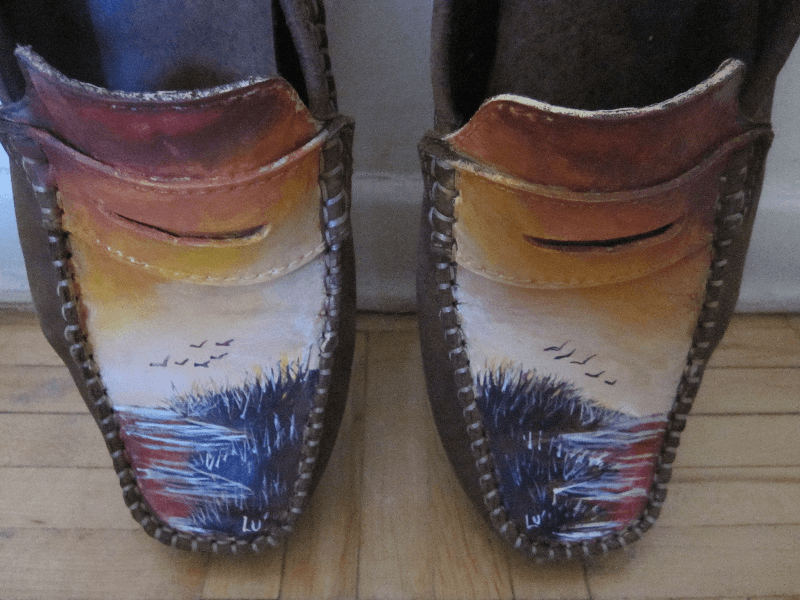BY LEANNE BENN
Life is a journey and sometimes you never know what to expect. Born in New Amsterdam, Guyana, Michael Lewis often finds himself reflecting on his past, his present and where he hopes to be. Before I even had a chance to speak to Mr. Lewis, I was captured by the beauty of one of his paintings displayed at the Last Lap Lime, held by members of the Guyanese diaspora.
What I saw in Lewis’s art was exactly what he tries to achieve through his work; to start a conversation without a single word. Growing up in Guyana, Lewis was part of a family with five siblings and everyone was always on a more technical path in life. Lewis knew that art and creativity were more his style. Standing out and maybe being the odd one out in the family helped him to push and achieve his dreams.
Despite having only minor artistic experience in school, he always had the passion to be creative he aspired to become an artist and to do great things. During his time in High School, Lewis came across many people who inspired him, one being Claude Stephens. Lewis would help him paint number plates for cars in the city. He taught Lewis how to prepare canvas, paint edges and other crafts. Lewis was his apprentice as he waited to move to the Burrowes School of Art in Georgetown.
Lewis graduated from the Berbice High School, in 1979. He moved to the city of Georgetown, Guyana, where he enrolled in the art school. While his other siblings went on to other things, Lewis stuck to his dream of art. Lewis spent four years at the art school, where he became influenced by ceramics and the style and craft of the practice. Eventually, Lewis became known as the best ceramist around and even graduated with a credit in ceramics. Though he never forgot about his love for painting.
Lewis dabbled a bit in everything even teaching a ceramics course at the Venezuelan Embassy and creating ceramic craft as gifts for Caricom summits, shareholder meetings for big organizations, and even for the President and Prime Minister at that time. By 1990 he received sponsorship to be featured at the World Trade Fair in Trinidad. Upon returning to Guyana, he decided he needed, even more training and obtained his Bachelor of Arts degree from the University of Guyana in the creative arts program where he was able to graduate in just two years thanks to his previous credit from the art school.
Lewis graduated in 1992 and soon after he married the love of his life, Nadine. Though knowing her for many years prior. As Lewis expressed, “when God has a plan things unfold in certain ways.”
Lewis is a man of few words, but Nadine became his marketing voice in helping him get odd jobs in the city and recommending him to almost anyone she met. Their teamwork and commitment let them form M&N Arts standing for Michael and Nadine. The couple successfully ran this little business all the while raising three kids and having outside jobs, of which Lewis became a visual arts teacher at Bishops High School in the city. Lewis took on any creative job he could find, which included painting banners for businesses, the design of city buildings, freelance contracts for construction companies because anything was possible to Lewis because creativity flows in his veins. When the opportunity came along in 2001, to become a visual arts specialist at a school in the Turks and Caicos, in just a matter of two weeks, Michael and Nadine sold everything and packed up their lives and kids and moved to the island.
Lewis was able to teach and share his artistic knowledge at the school up until he moved to Canada in 2011. It was upon moving to Canada, Lewis faced the challenges of new immigrants and stifled creativity in a completely different culture. For many years Lewis had to deal with simple adjustments, such as not even being able to find fresh clay as he was used to in Guyana to work on his ceramics.
Eventually, Lewis took his ideas to the canvas again, and no matter the time of day if he has an idea he takes note and gets started. Give Lewis any topic, subject surface, and style and he will get it done. From painting on leather shoes to hats, pants, canvas, and plates, Lewis has expresses his style in many ways.
Despite working a factory job, Lewis will paint at the end of the day to relax. This habit and with the help of Nadine, he offers Lewis Arts. Eventually, the couple hopes to establish this as a full-time business with a proper space and support for the community. If you are interested in Lewis’s work, contact him on 647-347- 8989 or email lewnad@yahoo.com .

